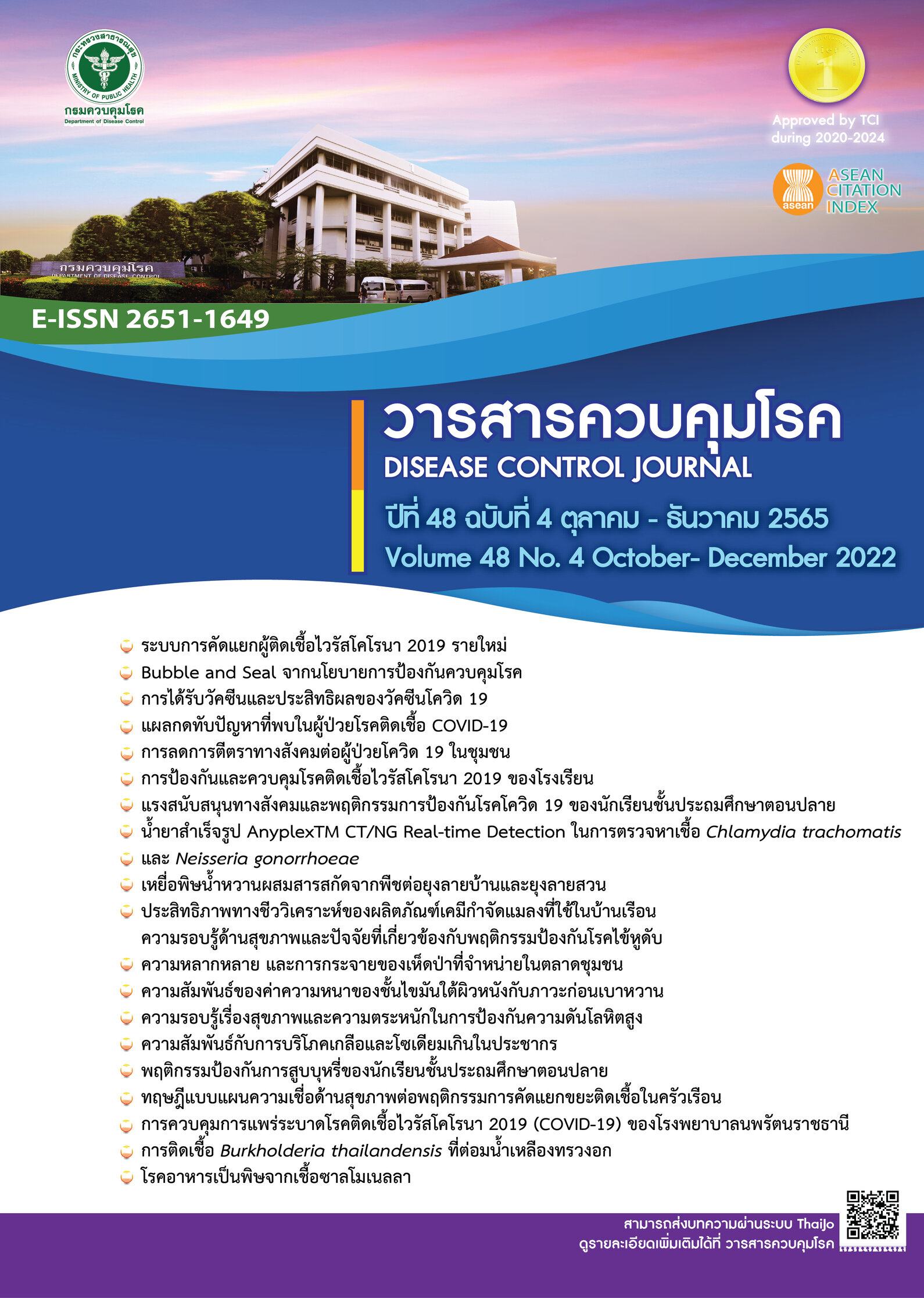A Case Report: Mediastinal lymph node infection caused by Burkholderia thailandensis in a Thai monk
DOI:
https://doi.org/10.14456/dcj.2022.78Keywords:
mediastinum, lymph node infection, Burkholderia thailandensisAbstract
Burkholderia thailandensis, the bacteria which is closely related to Burkholderia pseudomallei, the causative agent of melioidosis, rarely causes human infection. This report presents a case of mediastinal lymph node infection with this bacterium in a healthy 49-year-old Thai monk with a history of one pack-year cigarette smoking and exposure to soil around a temple in Prachin Buri Province. This is the second human case of B. thailandensis infection in Thailand. He presented productive cough and high-grade fever for two weeks and a nodular infiltration at the lateral segment of right middle lobe (RML) was noted on initial chest X-ray (CXR). His clinical symptoms did not improve after empirical treatment with ceftriaxone and no causative agent was isolated from sputum and blood culture. Widening mediastinum including the right paratracheal area was noted on follow-up CXR. Computed tomography (CT) of the chest demonstrated multiple rim enhancing mediastinal lymph nodes, 3.15 cm-diameter mass-like consolidation in the middle lobe of right lung and two lung nodules. B. thailandensis was isolated from microbiological culture of mediastinal lymph node concurrently with the results from indirect immunofluorescence assay (IFA) test revealed the melioid-IgM and IgG antibody titer more than four-fold rising from <1:50 and 1:50 to 1:800 and 1:1,600, respectively. After treatment with ceftazidime for five weeks together with sulfamethoxazole-trimethoprim, his clinical symptoms gradually improved. Decreasing size of the mediastinal lymph node and radiologic infiltration were observed on subsequent CXR.
Downloads
References
Brett PJ, Deshazer D, Woods DE. Characterization of Burkholderia pseudomallei and Burkholderia pseudomallei-like strains. Epidemiol Infect. 1997;118(2):137-48.
Brett PJ, DeShazer D, Woods DE. Burkholderia thailandensis sp. nov., a Burkholderia pseudomallei-like species. Int J Syst Bacteriol. 1998;48(1):317-20.
Ginther JL, Mayo M, Warrington SD, Kaestli M, Mullins T, Wagner DM, et al. Identification of Burkholderia pseudomallei near-neighbor species in the Northern Territory of Australia. PLoS Negl Trop Dis. 2015;9(6):e0003892.
Levy A, Merritt AJ, Aravena-Roman M, Hodge MM, Inglis TJ. Expanded range of Burkholderia species in Australia. Am J Trop Med Hyg. 2008;78(4):599-604.
Pearson T, Giffard P, Beckstrom-Sternberg S, Auerbach R, Hornstra H, Tuanyok A, et al. Phylogeographic reconstruction of a bacterial species with high levels of lateral gene transfer. BMC Biol. 2009;7:78.
Perry MB, MacLean LL, Schollaardt T, Bryan LE, Ho M. Structural characterization of the lipopolysaccharide O antigens of Burkholderia pseudomallei. Infect Immun. 1995;63(9):3348-52.
Smith MD, Wuthiekanun V, Walsh AL, Pitt TL. Latex agglutination test for identification of Pseudomonas pseudomallei. J Clin Pathol. 1993;46(4):374-5.
Tuanyok A, Mayo M, Scholz H, Hall CM, Allender CJ, Kaestli M, et al. Burkholderia humptydooensis sp. nov., a new species related to Burkholderia thailandensis and the fifth member of the Burkholderia pseudomallei complex. Appl Environ Microbiol. 2017;83(5):e02802.
Wiersinga WJ, van der Poll T, White NJ, Day NP, Peacock SJ. Melioidosis: insights into the pathogenicity of Burkholderia pseudomallei. Nat Rev Microbiol. 2006;4(4):272-82.
Chang K, Luo J, Xu H, Li M, Zhang F, Li J, et al. Human infection with Burkholderia thailandensis, China, 2013. Emerg Infect Dis. 2017;23(8):1416-8.
Gee JE, Elrod MG, Gulvik CA, Haselow DT, Waters C, Liu L, et al. Burkholderia thailandensis isolated from infected wound, Arkansas, USA. Emerg Infect Dis. 2018;24(11):2091-4.
Glass MB, Gee JE, Steigerwalt AG, Cavuoti D, Barton T, Hardy RD, et al. Pneumonia and septicemia caused by Burkholderia thailandensis in the United States. J Clin Microbiol. 2006;44(12):4601-4.
Lertpatanasuwan N, Sermsri K, Petkaseam A, Trakulsomboon S, Thamlikitkul V, Suputtamongkol Y. Arabinose-positive Burkholderia pseudomallei infection in humans: case report. Clin Infect Dis. 1999;28(4):927-8.
Zueter AM, Abumarzouq M, Yusof MI, Wan Ismail WF, Harun A. Osteoarticular and soft-tissue melioidosis in Malaysia: clinical characteristics and molecular typing of the causative agent. J Infect Dev Ctries. 2017;11(1):28-33.
Harvey J, Boles B, Brown D. A review of imaging findings in melioidosis: revealing the tropics’ dirty secret. Radiol Infec Dis. 2020;7(4):176-85.
Currie BJ, Ward L, Cheng AC. The epidemiology and clinical spectrum of melioidosis: 540 cases from the 20 year Darwin prospective study. PLoS Negl Trop Dis. 2010;4(11):e900.
Meumann EM, Cheng AC, Ward L, Currie BJ. Clinical features and epidemiology of melioidosis pneumonia: results from a 21-year study and review of the literature. Clin Infect Dis. 2012;54(3):362-9.
Zueter A, Yean CY, Abumarzouq M, Rahman ZA, Deris ZZ, Harun A. The epidemiology and clinical spectrum of melioidosis in a teaching hospital in a North-Eastern state of Malaysia: a fifteen-year review. BMC Infect Dis. 2016;16:333.
Muttarak M, Peh WC, Euathrongchit J, Lin SE, Tan AG, Lerttumnongtum P, et al. Spectrum of imaging findings in melioidosis. Br J Radiol. 2009;82(978):514-21.
Zhao J, Yap A, Wu E, Yap J. A mimic of bronchogenic carcinoma - pulmonary melioidosis. Respir Med Case Rep. 2020;29:101006.
Kho SS, Ho YF, Chan SK, Tie ST. Mediastinal melioidosis masquerading as malignancy of the lung. Lancet. 2021;397(10278):e8.
Ko SF, Kung CT, Lee YW, Ng SH, Huang CC, Lee CH. Imaging spectrum of thoracic melioidosis. J Thorac Imaging. 2013;28(3):W43-8.
Lim C, Peacock SJ, Limmathurotsakul D. Association between activities related to routes of infection and clinical manifestations of melioidosis. Clin Microbiol Infect. 2016;22(1):79 e1-e3.
Dissanayake HA, Premawansa G, Corea E, Atukorale I. Positive melioidosis serology in a patient with adult onset Still's disease: a case report of a diagnostic dilemma. BMC Rheumatol. 2018;2:37.
Downloads
Published
How to Cite
Issue
Section
License
Copyright (c) 2022 Disease Control Journal

This work is licensed under a Creative Commons Attribution-NonCommercial-NoDerivatives 4.0 International License.
Articles published in the Disease Control Journal are considered as academic work, research or analysis of the personal opinion of the authors, not the opinion of the Thailand Department of Disease Control or editorial team. The authors must be responsible for their articles.






